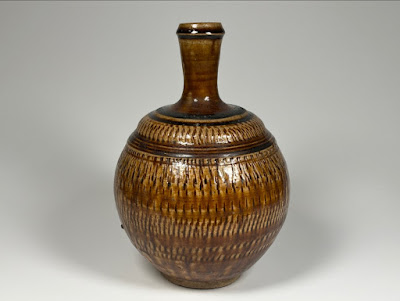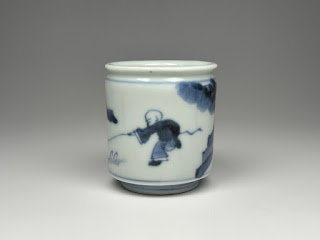梅花図 碗形猪口 Plum Blossoms Cup

Top width: 78 mm / Height: 51 mm / Bottom width: 38 mm 以前の記事 にも書いたが、こういった古手の碗形の猪口をみつけるとつい財布のひもがゆるんでしまう。正面に岩山(太湖石?)の上に生える梅の木と花が描かれ、裏には鳥が飛んでいる。梅の枝を境界線と見立てて、上側を呉須でぬりこめるのは、いかにも「江戸」を感じさせる独特のデザインである。大小の図案の対比、効果的な余白、高台内の一重圏線、端正な器形など、17世紀後半、時代が下ったとしても元禄期までとおもわれる、古い時代の猪口の特徴を備えているとおもう。 As I wrote before , this kind of old Imari cup is one of my favorites that loosen the purse strings. Ume (Japanese plum) tree and blossoms growing from a rocky hill are shown on one side, and a flying bird on the other side. The ume 's branches play a role of a boundary and the upper part is glazed in blue, which is so unique a design that it is definitely full of the Edo (old Japan in the 17th century to the early 19th century) flavor. This cup has several characteristics of the late 17th century's Imari cup such as a contrast of big and small drawings, an effective white margin, a blue circle at the bottom, and a well-made curved form. 最上手、というほどではないが、全体としてバランスのとれた、この時代の佳作といえるだろう...


